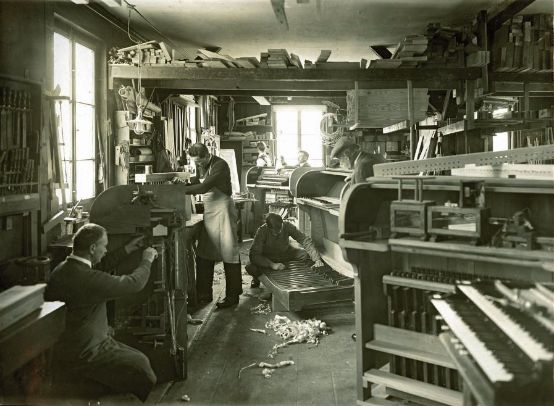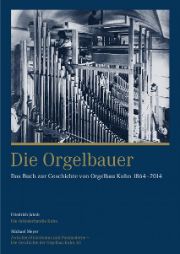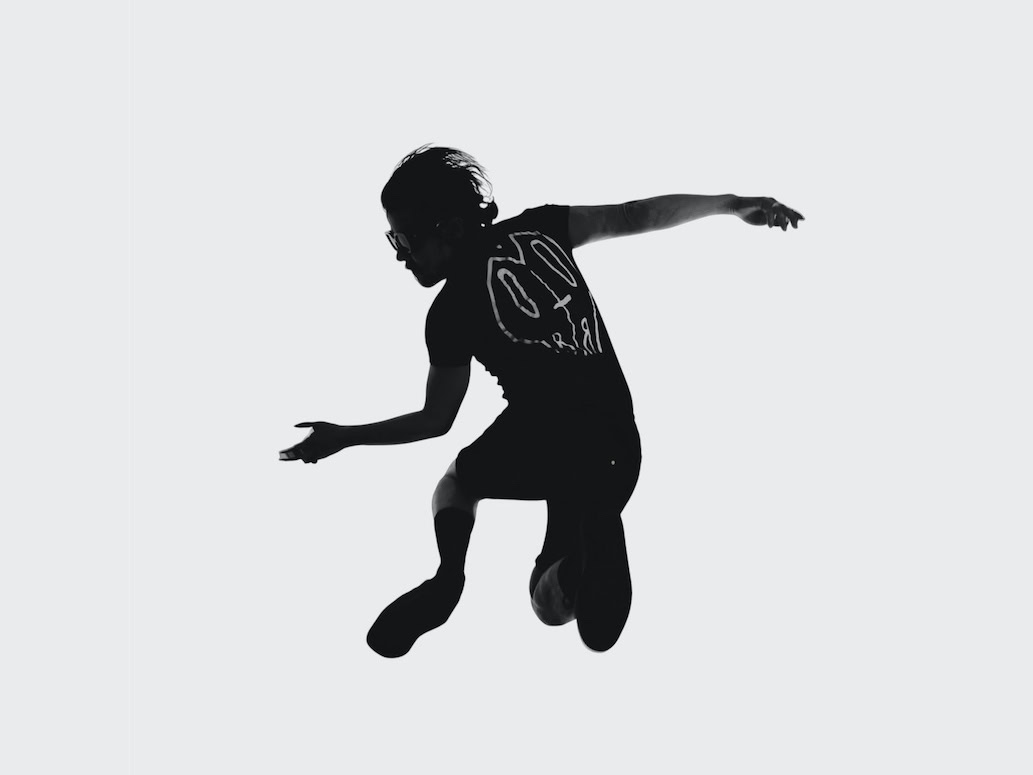150 years of organ building
To mark its anniversary, Kuhn AG has published a comprehensive company history. In addition to the family history, it also reflects upheavals and trends in organ building.

Friedrich Jakob was director of Orgelbau Kuhn AG Männedorf from 1967 to 1999 and published a brief history of the company in 1987. While most of his numerous essays and 18 extensive books comprehensively describe a specific organ, here he ventures a historical overview and assessment of the development of organ building based on the company from 1864 to 1925, the year of the death of Theodor Kuhn, son of the company founder. He does this with the same meticulousness, source research and healthy skepticism towards previous literature, in which he finds and corrects some errors.
Who was the company founder Johann Nepomuk Kuhn and why did he end his wanderings in Männedorf? Until now, we were completely in the dark. Thanks to years of research in public and private archives, we now know a lot about his origins in Bad Waldsee in Württemberg, his training in the Walcker-Weigle-Laukhuff circle and his years as a journeyman. He was born out of wedlock, which was dishonorable and hushed up at the time. This makes his outstanding professional skills in the technical and tonal fields all the more astonishing. He is universally praised for his conscientiousness, loyalty, punctuality and diligence; he is also described as solid, modest and caring, which indicates a good upbringing and strength of character.
He came to Männedorf in 1863, aged 36, together with Johannes Spaich, to install the first church organ, built by Eberhard Friedrich Walcker, in the reformed church. Both were encouraged and supported by members of the congregation to found a company here in 1864. This company immediately received honorable commissions for new buildings, in 1865 in Dittingen BL, Catholic Church, and in 1867/68 even for three-manual organs in the Grubenmann Church in Wädenswil and in St. Martin's Church in Chur. Their last joint work, op. 20, built in 1872 for the old Tonhalle in Zurich, was splendidly resurrected in 1995 in Zurich's Neumünster with the basic pipes and case. Spaich parted company with Kuhn in 1872 to set up his own manufactory in Rapperswil. Of the 55 other new buildings up to the year of Kuhn's death in 1888, let us mention only the most important: Zurich St. Peter's, Grossmünster and Fraumünster; St. Gallen Cathedral; Schaffhausen St. Johann and the Catholic church of St. Maria (originally for the national exhibition in Zurich in 1881).
Kuhn equipped all of the organs with Walcker-developed stop chests and cone valves, the three-manual organs with Barker levers to facilitate the necessary key pressure. The only two organs restored to their original state, the latter op. 52 and op. 40 in the Christian Catholic church in Olten, bear witness to the sophisticated, durable technology and tonal refinement from the most delicate whispering to the grave, still moderate roar. He deviated as little as possible from proven pipe shapes, spatial arrangements and dispositions. As the author points out, this is a guarantee and probably also a prerequisite for the highest quality. Jakob also studied physics. Refreshingly readable remarks bear witness to this, for example about elaborate "expressions" (pipe extensions), a "sound improvement" praised at the time and still today, which have no acoustically measurable effects.
After falling ill in 1887, Nepomuk Kuhn brought his only descendant Theodor (1865-1925) back after two years abroad and immediately made him a partner in the company. He is said to have played the piano and organ well in his early years. However, he devoted all his creative energy to the technical and commercial development of the company. He remained a bachelor and left almost no personal papers. As a result, we know almost nothing about Jakob's career, his apprenticeship and journeyman years or his friendships, except for the names of two long-standing friends with whom he founded a limited company one year before his death to ensure the continuation of his business. This and the fact that he donated a considerable part of his fortune to support apprentices show a good, fatherly and caring, albeit strict, patron, similar to his father. His technical achievements, on the other hand, are precisely documented, especially the pneumatic action and stop action, which he rushed to introduce. This almost led to bankruptcy in 1895. He continued to perfect pneumatics with foreign and his own patents.
Pneumatic organs were later decried as decadent factory-made products in the wake of the organ movement. Their disadvantage, a slight delay between key and pipe, was exaggerated, but their longevity was underestimated. They have survived even more rarely than their predecessors with mechanical cone chests. After Kuhn's magnificent organ for the church of St. Jakob in Zurich, built in 1902, was extended in a "baroque" style and converted to electric action in the 1980s (today it has been restored in a good way, as far as technically possible), we can admire his only organ restored to its original state in 1914 (2002) in the Catholic church of St. Anton, carefully and lovingly restored to its original splendor of sound by the same firm. There are enchanting, even pastel-like mixtures of sound, created by exotic labials, reed stops in the French style (including resounding ones) and the large Schwellwerk. Jakob also aptly describes Theodor Kuhn's stylistic development: while his father remained attached to German Romanticism, his son increasingly took French Romanticism into account, which is in line with the Swiss participation in both cultural spheres and later became generally noticeable in organ building.
Jakob's general explanations are exciting to read and easy to understand, even for laypeople. With great attention to detail and richly illustrated, he presents all the people and companies involved as well as selected organs. With the sources used, he adds comprehensive documentation that nevertheless omits the unimportant, a treasure trove for specialists!
Jakob's part of the book comprises around 300 two-column A4 pages, more than half of which are filled with sources. The second author, Michael Meyer, who traces the continuation of the company's history up to the present day on 55 pages, takes a different approach to his task: He limits himself to the major lines of development based on a cursory presentation of 14 new buildings and 6 restorations, touches on technical developments and presents the economic-historical perspective with concise text and diagrams. Meyer is a musicologist and organist, but not an organ builder. His concept certainly has advantages for readers interested in history. The omission of organ-building details also makes sense insofar as the objects are described in all desirable detail on the basis of individual illustrations, inauguration documents, the complete company archive and the Internet organ database (www.orgelbau.ch) are recorded. An example mentioned only twice in passing in Meyer's text is the restoration in St. Anton (1997-2002), which was made possible by organist Heinz Specker's many years of reconnaissance and collecting activities, and his inaugural publication, enriched by contributions from renowned experts.
Meyer carefully discusses the setbacks during the war and post-war years and expertly describes the lengthy, gradual development of a contemporary restoration technique, which has become an increasingly important branch of Kuhn's business. It owes much to the experts Schiess (appreciation in Acta organologica 31, 2009, p. 399) and Koller, but then since the appointment of Friedrich Jakob in 1963 and Wolfgang Rehn (1974-2014). Gaps are unavoidable. For example, the groundbreaking rebuilding of the Bern Minster organ in 1930 is described, but its removal by the most recent rebuilding in 1999 is not. The unresolved cause of both rebuilds is the choir arch, which was massively reinforced at the beginning of the 20th century and behind which the organ's sound outlet into the room is severely obstructed. The Basel cathedral organ from 1956 (now in the Roman Catholic cathedral in Moscow) and the restoration of the Bommer organ in St. Katharinenthal TG (1965-69) with a later return to unequal temperament are also sought in vain. These are minor blips in the company's otherwise successful history, culminating in many honorable foreign commissions despite the strong Swiss franc. The largest order ever placed was recently the restoration of the huge Steinmeyer organ in Trondheim.
Finally, after the lists of all shareholders, managers and employees since 1925 (with photos) as well as old to recent illustrations of the property and work processes, we would like to pay tribute to the managing director Dieter Utz (2000-2014), who edited this magnificent volume. An interview conducted with him by Pierre Freimüller sheds light on his outstanding company culture, the key to his artisanal and economic success.
Dieter Utz (ed.), Die Orgelbauer. The book on the history of Orgelbau Kuhn 1864-2014. Friedrich Jakob: The founding Kuhn family - Michael Meyer: Between historicism and postmodernism - The history of Orgelbau Kuhn AG. Hardcover, 432 p., A4 format, with 170 illustrations and 8 diagrams, Fr. 68.30, Verlag Orgelbau Kuhn, Männedorf 2014, ISBN 978-3-033-04728-0









